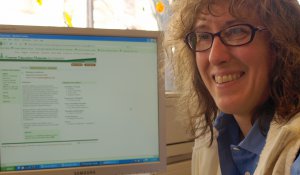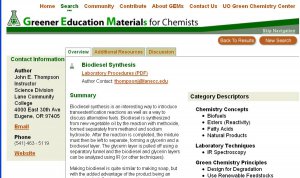 EUGENE, Ore. -- (March 24, 2009) -- A database designed to "build community" and reduce barriers when adopting green chemistry has doubled in size in the last two years, its creator told professional colleagues at the national spring meeting of the American Chemical Society.
EUGENE, Ore. -- (March 24, 2009) -- A database designed to "build community" and reduce barriers when adopting green chemistry has doubled in size in the last two years, its creator told professional colleagues at the national spring meeting of the American Chemical Society.
"We now have more than 100 items in the GEMs database that are available for educators," said Julie Haack, assistant head and senior instructor in the University of Oregon's chemistry department. "There is a tremendous amount of choice, and the items are much more sophisticated now that a lot of educators have contributed to each item. This is really a new approach to the development of education materials. It is very much a community-based approach."
Haack was referring to Greener Education Materials for chemists, which she first unveiled in June 2005 as a "living database" that for the first time corrals and organizes into a repository a wealth of resources supporting the teaching of green principles and strategies across chemical disciplines.
In her ACS talk in Salt Lake City, Haack described new additions to GEMs, which currently is heavy on organic chemistry but expanding to incorporate green chemistry strategies in nanotechnology, materials sciences, biochemistry and analytical chemistry.
The goal of GEMs is to help put green chemistry into curriculum at all levels by providing information about laboratory exercises, lecture materials, course syllabi, multimedia content, homework assignments and any other avenues educators may choose to use. The project began with support of the National Science Foundation and the UO College of Arts and Sciences.
 Items in the database refer to subject areas where a faculty member can contribute a topic. For instance, she said, one item started when a Lane Community College instructor in Eugene submitted an entry on biodiesel synthesis. Educators who have used information supplied in the entry have responded, much in the way threaded discussions are used in email, with concerns, suggestions, adaptations to the original item and potential classroom uses.
Items in the database refer to subject areas where a faculty member can contribute a topic. For instance, she said, one item started when a Lane Community College instructor in Eugene submitted an entry on biodiesel synthesis. Educators who have used information supplied in the entry have responded, much in the way threaded discussions are used in email, with concerns, suggestions, adaptations to the original item and potential classroom uses.
Another item, submitted by a UO chemist, has seen nine subsequent contributions, Haack said.
"Each item is a living piece. What we've noticed is that greening is a process," she said. "So you might make one change that makes the lab or an activity greener than the version before, but then you can improve it again and again and again. How do you capture that? With a whole new item every time? What we chose to do was have a threaded discussion."
A high-school teacher might visit the site looking for teaching material. As of early March, GEMs contained 33 items appropriate for high-school students. "It's really easy for educators to find what they need," Haack said. "You can search by a concept -- such as enzyme kinetics or spectroscopy -- that helps find green alternatives that you can incorporate into your lessons."
Doug Young, a doctoral student in chemistry at the UO, has led the effort to speed the addition of items to the database, Haack said. Young chose the UO for graduate school because of its reputation in green chemistry.
The UO has trained 160 educators from across the country in summer green-chemistry workshops funded by the National Science Foundation. UO chemistry professors Jim Hutchison and Ken Doxsee, Young's faculty adviser, established the nation's first green-chemistry teaching laboratories in 1998.
Haack also focused her ACS talk on the contributions of undergraduate chemistry student Dana R. Garves, who has been studying green-chemistry adoptions and where they have occurred. Her research has led to the addition of a "Schools" tab in GEMs that allows educators to locate colleagues who already have put green chemistry in their programs.
A related helpful tool, new to the arsenal since GEMs began, is a Google Map feature found under a "Community" tab. Users can generate a map by topic or organizational types to find other individuals interested in green chemistry anywhere in the world.
The GEMs database was designed in collaboration with the UO Interactive Media Group. The new features presented at the ACS meeting were designed in collaboration with analyst programmer Robert Albano of the UO's department of chemistry.